I can still picture that wide, California sunshine grin on my host friend’s face as he told me, “Don’t make dinner plans for Monday night.” I didn’t. As we had for many of our meals on this Bay Area trip, my Belgian travel buddy and I left restaurant selection up to him, fully confident that he would not lead us astray. He didn’t. That Monday night, we dined at Chez Panisse Café, opened by Alice Waters in 1980 right above the Chez Panisse main restaurant as a way to make her food more accessible to those eager to try it. While the café features most of the same local, organic ingredients as the restaurant, it’s menu is a daily-rotating a la carte that gives the guest more options than the daily-rotating prix fixe downstairs. The café even has its very own charcoal grill and wood-burning oven, which we indirectly ended up taking full advantage of in our own meal.
A little history, I feel, is necessary here on Chez Panisse and it’s famous proprietor, Alice Waters. Chez Panisse was named Best Restaurant in America in 2001 by Gourmet. It was ranked one of the top 50 restaurants in the world for 7 consecutive years (from 2002 to 2008) by Restaurant magazine. It received a Michelin each year from 2006 through 2009. The California-style pizza, featuring a variety of local ingredients, was said to have been created there in 1980.
The iconic restaurant was founded in 1971 upon a principle which is now pretty widely acknowledged but was back then a relatively novel idea in the U.S.: Cooking should be based on fresh, seasonal ingredients that are produced sustainably and locally. Waters and her co-founder, Paul Aratow, were inspired by their travels to France, where the food and market culture centered (as it does today) on the concept of locally grown and fresh stuff. This stood out as a contrast to the high-end restaurants in the U.S. which, at that time, did not stress these two qualities as much. Chez Panisse has always prided itself on maintaining excellent (some decade-long) relationships with a very sturdy network of local farmers, ranchers and dairies.
Having left the kitchen in very able hands, Waters is rarely at Chez Panisse anymore. Nowadays, she’s probably pretty busy being one of the most well-known food activists around the world. Among various other do-good’er activities, she runs Edible Schoolyard, a program that involves students at Martin Luther King Jr. Middle School in Berkeley in all aspects of farming and food prep. The program is meant to “encourage awareness and appreciation of the transformative values of nourishment, community and stewardship of the land.” You know the kind of thing Michelle Obama is trying to do with the White House organic vegetable garden? That kind of thing. Alice Waters.
While Tony Bourdain has expressed serious beef with the unrealistic nature of what Waters expects of Americans in terms of dietary choice, he seems to also admit to the value of the philosophy expressed through Chez Panisse. He once said, “True, I am suspicious of wealthy suburbanites who preach ‘back to the soil’ philosophies, as if most — or even many — could start digging subsistence gardens in their back yards or afford expensive organic or locavore lifestyles. But Chez Panisse was inarguably a cradle of the food revolution. I respect Alice Waters’ enormous contribution to changing the way we eat and cook today. No one can take that away from her. No one should try.”
I’m glad I got to experience her legacy first-hand.
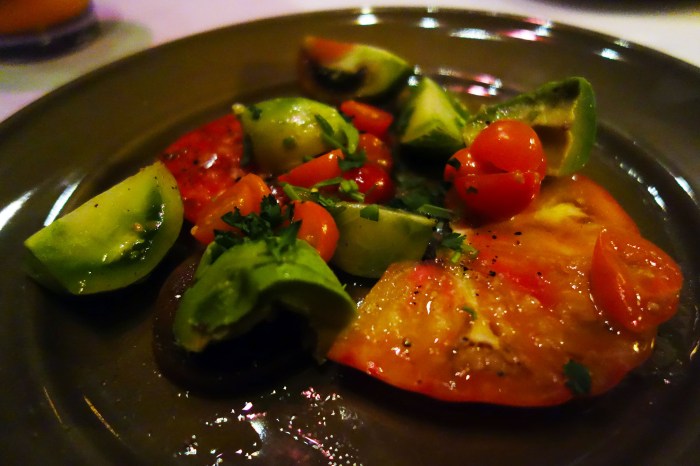
 I think I managed to incorporate heirloom tomatoes into almost every single meal I had on my trip to San Francisco. And I was right to do so… At Chez Panisse, we started with an Heirloom Tomato and Avocado Salad, which came sprinkled with grated ginger and cilantro. Fresh-to-death tomatoes in a wide array of sizes and a rainbow of shades. They were sliced into wedges and disks for a nice alternation in textures and served with amorphous hunks of buttery ripe avocado. The ginger added a floral zing and spice, while the cilantro gave the salad a citric, herbal kick. Then, a trace amount of good olive oil, coarse salt and pepper. A no-brainer besides some creativity with adding ginger, really just a way to show off incredible produce that speaks for itself. One dish every guest should order.
I think I managed to incorporate heirloom tomatoes into almost every single meal I had on my trip to San Francisco. And I was right to do so… At Chez Panisse, we started with an Heirloom Tomato and Avocado Salad, which came sprinkled with grated ginger and cilantro. Fresh-to-death tomatoes in a wide array of sizes and a rainbow of shades. They were sliced into wedges and disks for a nice alternation in textures and served with amorphous hunks of buttery ripe avocado. The ginger added a floral zing and spice, while the cilantro gave the salad a citric, herbal kick. Then, a trace amount of good olive oil, coarse salt and pepper. A no-brainer besides some creativity with adding ginger, really just a way to show off incredible produce that speaks for itself. One dish every guest should order.
 Another awesome starter was the Roasted Eggplant Soup, a delightfully comforting and thick puree of smokey roasted eggplant and red peppers for some extra caramelized sweetness. This was a special dish for me because it was probably the first hot soup of the year that really hit the spot after a chilly autumn day. The warm, velvety soft blanket of soup was nicely painted over with a cool dash of tangy yoghurt, which provided a great contrast, waking up the sleepy flavors of the pureed vegetables with its acidity. The bright white sheen of the yoghurt was also rather beautiful juxtaposed with the rusty orange-red of the soup. Fresh green chive painted little lines over the plate. Toasty-warm, intense in flavor and beautiful. Definitely one of my favorite dishes of the night.
Another awesome starter was the Roasted Eggplant Soup, a delightfully comforting and thick puree of smokey roasted eggplant and red peppers for some extra caramelized sweetness. This was a special dish for me because it was probably the first hot soup of the year that really hit the spot after a chilly autumn day. The warm, velvety soft blanket of soup was nicely painted over with a cool dash of tangy yoghurt, which provided a great contrast, waking up the sleepy flavors of the pureed vegetables with its acidity. The bright white sheen of the yoghurt was also rather beautiful juxtaposed with the rusty orange-red of the soup. Fresh green chive painted little lines over the plate. Toasty-warm, intense in flavor and beautiful. Definitely one of my favorite dishes of the night.
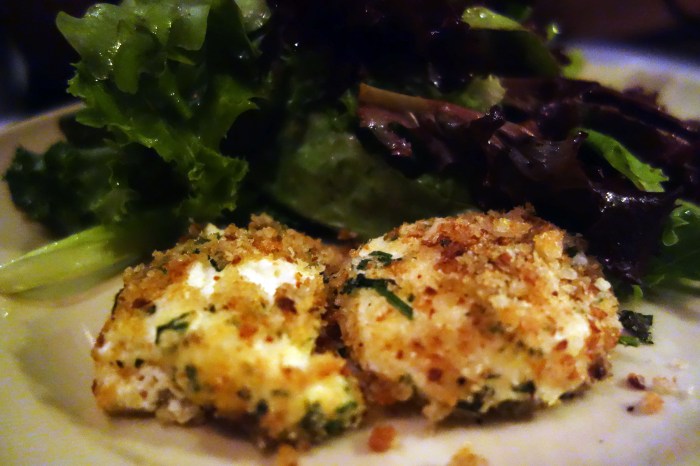 And then there was the Warm Baked Andante Dairy Goat Cheese, which came topping a bed of fresh, springy garden lettuces. My Belgian friend was not too impressed, but then again, she’s Belgian and takes her constant accessibility to quality goat cheese for granted. I do not. Two pillow-soft balls of dense yet airy-light, toasty warm goat cheese, wonderfully tart and nutty in flavor. These were coated in golden brown panko-type breadcrumbs, which added a nutty, oily toast flavor. Their crunch took over in texture – snapping, crackling and popping like Pop Rocks on the tongue – after the balls of goat cheese melted into a silky-soft spread. Chewing is hardly necessary with this one, pushing my tongue up against the roof of my mouth to squish the cheese was enough to release all of its wonderful acidity and sweetness. Fresh herbs mixed into the breading added a good layer of flavor as well. Garden lettuces on the side were leafy, crisp and refreshing, cool against the warmth of the cheese. I eventually came to learn that this dish was one of the first ones ever offered at Chez Panisse, back in the 1970s. Thankfully not much has changed to the recipe since then.
And then there was the Warm Baked Andante Dairy Goat Cheese, which came topping a bed of fresh, springy garden lettuces. My Belgian friend was not too impressed, but then again, she’s Belgian and takes her constant accessibility to quality goat cheese for granted. I do not. Two pillow-soft balls of dense yet airy-light, toasty warm goat cheese, wonderfully tart and nutty in flavor. These were coated in golden brown panko-type breadcrumbs, which added a nutty, oily toast flavor. Their crunch took over in texture – snapping, crackling and popping like Pop Rocks on the tongue – after the balls of goat cheese melted into a silky-soft spread. Chewing is hardly necessary with this one, pushing my tongue up against the roof of my mouth to squish the cheese was enough to release all of its wonderful acidity and sweetness. Fresh herbs mixed into the breading added a good layer of flavor as well. Garden lettuces on the side were leafy, crisp and refreshing, cool against the warmth of the cheese. I eventually came to learn that this dish was one of the first ones ever offered at Chez Panisse, back in the 1970s. Thankfully not much has changed to the recipe since then.
 My friend got the steak special of the evening, a grilled skirt with a creamy herbed marrow butter spread on, with a side of what seems to be the Chez’s signature side, crispy and brittle shoestring potatoes. The quality of the meat was excellent; I think I remember it to be from Magruder Ranch, close-by. It was cooked a bit to the medium-rare side, despite the request for rare, but remained wonderfully juicy and quite bloody inside. The crust was not overdone in the least, but seasoned very well and the marrow added a mouth-watering buttery moisture that licked the crispy, charred crust. The shoestring potatoes did their job very well, each piece crunchy and caramelized golden-brown. A nice steak frites special which came with a wonderfully tannic red at a price that was shockingly moderate.
My friend got the steak special of the evening, a grilled skirt with a creamy herbed marrow butter spread on, with a side of what seems to be the Chez’s signature side, crispy and brittle shoestring potatoes. The quality of the meat was excellent; I think I remember it to be from Magruder Ranch, close-by. It was cooked a bit to the medium-rare side, despite the request for rare, but remained wonderfully juicy and quite bloody inside. The crust was not overdone in the least, but seasoned very well and the marrow added a mouth-watering buttery moisture that licked the crispy, charred crust. The shoestring potatoes did their job very well, each piece crunchy and caramelized golden-brown. A nice steak frites special which came with a wonderfully tannic red at a price that was shockingly moderate.
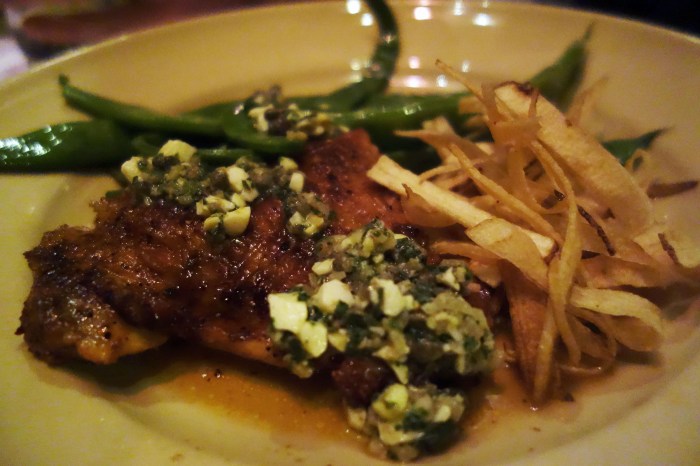 My host friend ordered the Riverdog Farm Chicken Leg Alla Diavola (Devil style!) with some shoestring potatoes, crunchy Romano beans and a salsa rustica. The chicken leg was grilled over fire to a moist, tender point, while the skin remained nice and crispy. Very good, although I never get too excited about chicken and this was no exception. I honestly don’t remember this dish too well and reached mainly for a handful of shoestring fries when my friend offered his plate up for critique. The fries stole the show.
My host friend ordered the Riverdog Farm Chicken Leg Alla Diavola (Devil style!) with some shoestring potatoes, crunchy Romano beans and a salsa rustica. The chicken leg was grilled over fire to a moist, tender point, while the skin remained nice and crispy. Very good, although I never get too excited about chicken and this was no exception. I honestly don’t remember this dish too well and reached mainly for a handful of shoestring fries when my friend offered his plate up for critique. The fries stole the show.
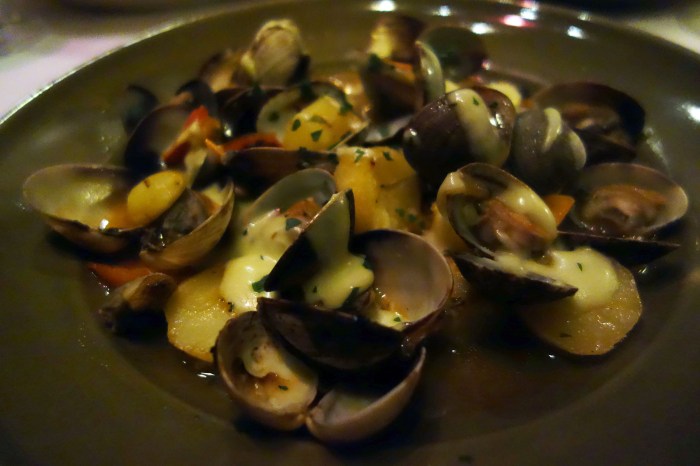
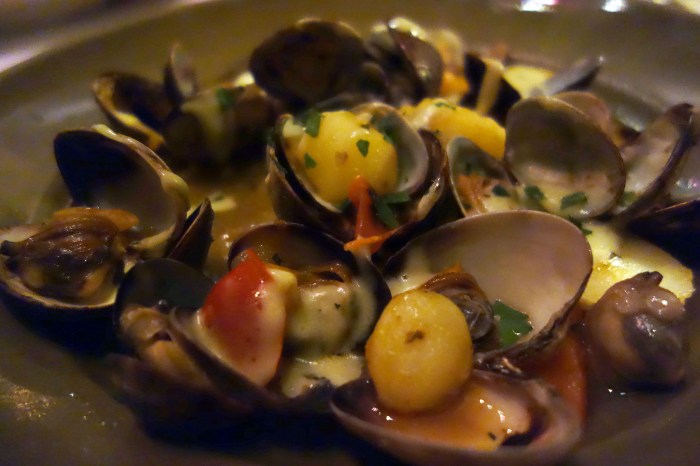 The entree I remember the most was my own, the Hog Island Clams Cooked in the Wood Oven with peppers and new potatoes. These were heavenly. Perfectly succulent and extremely flavorful Manilla clams tasted of the sea and the creamy white wine sauce drizzled over. The slightly chewy, tender meat was contrasted by plump, not too starchy little balls of new potato which were cooked to the perfect texture – mushy, soft and buttery when bitten into but maintaining a crisp, tight exterior. The slivers of pepper were likewise great in there, slippery-smooth and playing around in the sauce with their marine buddies. Some non-pasta-topper clam dishes have a tendency to leave the eater unsatisfied, as most of the volume of the plate is taken up by shell which gets discarded anyway. Not this one. The clams, when combined with the veggies, made for a very full dish, hearty though not too heavy, even with the cream sauce. I’m glad I picked this one, though my second choice – the Llano Seco Ranch Pork Meatballs – didn’t look bad either…
The entree I remember the most was my own, the Hog Island Clams Cooked in the Wood Oven with peppers and new potatoes. These were heavenly. Perfectly succulent and extremely flavorful Manilla clams tasted of the sea and the creamy white wine sauce drizzled over. The slightly chewy, tender meat was contrasted by plump, not too starchy little balls of new potato which were cooked to the perfect texture – mushy, soft and buttery when bitten into but maintaining a crisp, tight exterior. The slivers of pepper were likewise great in there, slippery-smooth and playing around in the sauce with their marine buddies. Some non-pasta-topper clam dishes have a tendency to leave the eater unsatisfied, as most of the volume of the plate is taken up by shell which gets discarded anyway. Not this one. The clams, when combined with the veggies, made for a very full dish, hearty though not too heavy, even with the cream sauce. I’m glad I picked this one, though my second choice – the Llano Seco Ranch Pork Meatballs – didn’t look bad either…
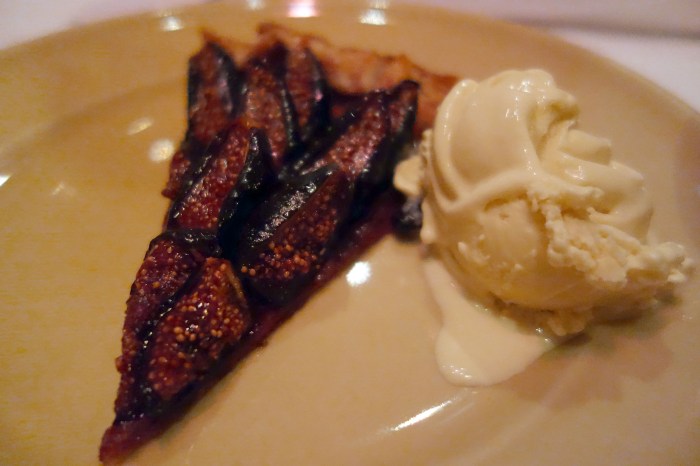
 Though I continue to rave about Hog Island clams and eggplant soup when Chez Panisse is brought up in conversation (which it does, and with surprising frequency), my favorite-favorite dish of the night was actually one of our desserts, the Black Mission Fig Galette with Wild Fennel Ice Cream. With this one it’s not too difficult to know where to start: the figs. Oh the figs… Chewy, gooey, stick-to-your teeth caramelized wonder, with a natural sweetness akin to maple and a very slight bitterness lingering in the blackened skin. The texture of the roasted fruit was mushy and satisfying, with the crispy little seeds adding a funky texture to keep the tongue from falling into a endorphin-induced trance. Moving onto the crust, which actually stood up in quality to the flawless produce topping it, a fact that I very much appreciated. A buttery, flaky pie shell with just the right amount of sweetness to let the fig shine, but to back it up still. None of that unpleasant undercooked baking soda harshness – just golden-brown, crumbly smooth sailing. The wild fennel ice cream on the side was perhaps the best compliment I could imagine, both in cutting the toasty warmth of the galette with its icy coolness and moving the ripe sweetness of the fig into a slightly savory, green, herbal direction. The flavor of the fennel when combined with the fruit added a maddeningly fantastic complexity to the dish, in a way similar to how incorporating aged balsamic into a dessert can do it wonders. After a slightly disappointing fig dessert (which ended up pretty fig-less, indeed) only a few days prior, this dessert was a heaven-send.
Though I continue to rave about Hog Island clams and eggplant soup when Chez Panisse is brought up in conversation (which it does, and with surprising frequency), my favorite-favorite dish of the night was actually one of our desserts, the Black Mission Fig Galette with Wild Fennel Ice Cream. With this one it’s not too difficult to know where to start: the figs. Oh the figs… Chewy, gooey, stick-to-your teeth caramelized wonder, with a natural sweetness akin to maple and a very slight bitterness lingering in the blackened skin. The texture of the roasted fruit was mushy and satisfying, with the crispy little seeds adding a funky texture to keep the tongue from falling into a endorphin-induced trance. Moving onto the crust, which actually stood up in quality to the flawless produce topping it, a fact that I very much appreciated. A buttery, flaky pie shell with just the right amount of sweetness to let the fig shine, but to back it up still. None of that unpleasant undercooked baking soda harshness – just golden-brown, crumbly smooth sailing. The wild fennel ice cream on the side was perhaps the best compliment I could imagine, both in cutting the toasty warmth of the galette with its icy coolness and moving the ripe sweetness of the fig into a slightly savory, green, herbal direction. The flavor of the fennel when combined with the fruit added a maddeningly fantastic complexity to the dish, in a way similar to how incorporating aged balsamic into a dessert can do it wonders. After a slightly disappointing fig dessert (which ended up pretty fig-less, indeed) only a few days prior, this dessert was a heaven-send.
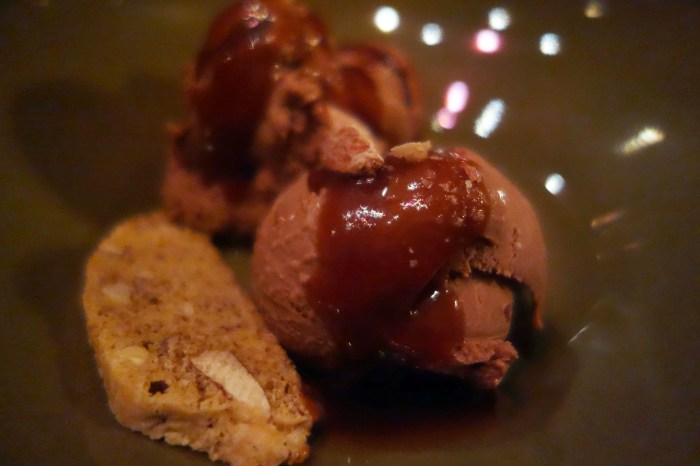 Our second dessert was okay, though definitely overshadowed by the fig galette. Clay’s Bittersweet Chocolate Ice Cream with a slightly salted caramel sauce and crunchy candied almonds sprinkled over the top. Served with it was a piece of Alice’s signature Chez Panisse Biscotti, a crunchy twice-baked with slivers of almond and a very subtle hint of anise lingering shyly in the background. The almond in the biscotti waived happily to the almonds sprinkled over the ice cream, and the caramel went nicely with the nutty, toasted flavors. The flavor of the ice cream was nice, bitter and deep, a gelato at heart. I wish the ice cream had been served at a slightly higher temperature though, as it seemed a tad too frigid still and was difficult to warm up enough to enjoy. The flavors of the chocolate were tied up a bit by the frost and I just think serving it slightly more melted on the exterior would’ve allowed those flavors to come out more. It also would’ve provided a bit of moisture for the biscotti to soak up – as it stood, both ice cream and biscotti were rather hard and didn’t really have too much to say to one another. Maybe I should’ve asked for a cappuccino to dip in…
Our second dessert was okay, though definitely overshadowed by the fig galette. Clay’s Bittersweet Chocolate Ice Cream with a slightly salted caramel sauce and crunchy candied almonds sprinkled over the top. Served with it was a piece of Alice’s signature Chez Panisse Biscotti, a crunchy twice-baked with slivers of almond and a very subtle hint of anise lingering shyly in the background. The almond in the biscotti waived happily to the almonds sprinkled over the ice cream, and the caramel went nicely with the nutty, toasted flavors. The flavor of the ice cream was nice, bitter and deep, a gelato at heart. I wish the ice cream had been served at a slightly higher temperature though, as it seemed a tad too frigid still and was difficult to warm up enough to enjoy. The flavors of the chocolate were tied up a bit by the frost and I just think serving it slightly more melted on the exterior would’ve allowed those flavors to come out more. It also would’ve provided a bit of moisture for the biscotti to soak up – as it stood, both ice cream and biscotti were rather hard and didn’t really have too much to say to one another. Maybe I should’ve asked for a cappuccino to dip in…
Overall, I had a great experience that evening. I had been expecting the Chez to put on airs much higher than it actually did. The place is set in a cool Arts and Crafts house and the atmosphere seemed comfortable, intimate and informal. Our server was a very nice older gentleman who, after noting my excitement over the fact that they feature Tokaji on their dessert wine list, brought me out a Hungarian Furmint to try out. I ended up ordering it and this great wine lead me by the hand through the line of excellent dishes hitting out table at a well-timed pace. If ever in Berkeley, I will be back for the set dinner experience downstairs.


